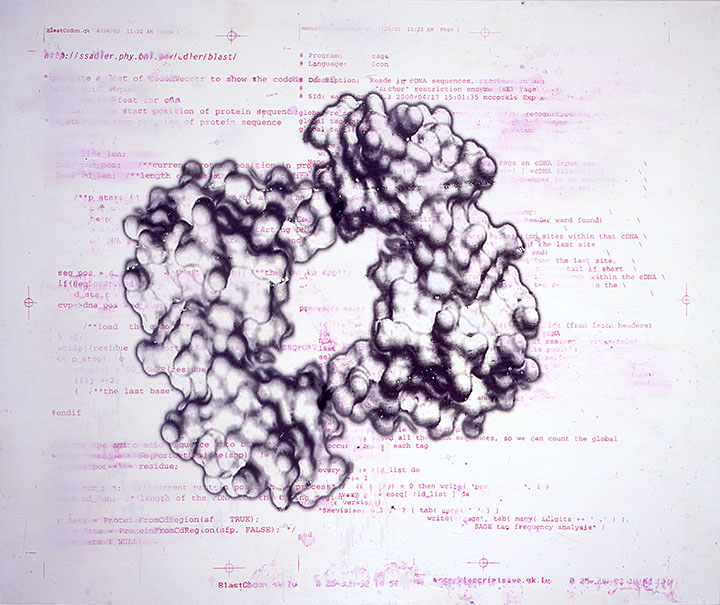Genome Issue(s): Art and Science
The Graduate Center of City University of New York
February 26th – April 5th, 2003
New York
 Master Plan, 2000
Master Plan, 2000
Survey exhibition probes implications of genetic breakthroughs, and finds beauty in the life process
The Art Gallery of The Graduate Center of The City University of New York will present Genomic Issue(s): Art and Science from February 26 to April 5. \\
The exhibition offers the public an opportunity to see how artists are interpreting the accelerating breakthroughs in present-day genetic research. The international artist roster includes practitioners who aim to image the enormous complexity and visual beauty at the core of life, and those who address the social, political and economic dilemmas that arise from new biotechnological applications in human, animal and plant life. The exhibition includes works by Marc Quinn, Yasumasa Morimura, Bryan Crockett, Steve Miller, Miwa Yanagi, Maiko Koie, Eduardo Kac, Ellen Sandor, Christa Erickson, Ross Bleckner, Frank Moore, Beryl Korot, and Catherine Wagner, plus composers Todd Barton and Steve Reich. There will also be an accompanying series of public programs in March.
Genomic Issue(s) has been organized as part of an international observance of the 50th anniversary of the discovery of the double-helix structure of DNA. New York City is one of the event capitals: a citywide festival of exhibitions and cultural programs will unfold throughout the city from mid-February to early April.
Nobel Prize-winner Dr. James D. Watson, who with Dr. Francis Crick first comprehended the double-helix structure, says, “We instantly saw the double helix to be a big step forward for genetics if not for all of biology. Neither of us, in early 1953, however, could have imagined how thinking at the DNA level so dominates today’s biology and medicine.”
“The discovery of the double-helix structure of DNA underpins the accelerated pace of invention and discovery in contemporary genetic research,” says Karen Sinsheimer, a curator at the Santa Barbara Museum of Art in California and the organizer of Genomic Issue(s). Continues Sinsheimer, “The artists represented in this exhibition are an important part of the scientific dialogue, as they give form to ideas in the open-ended language of artmaking. They are placing some of the most urgent issues of our time into the public sphere.” Sinsheimer has organized Genomic Issue(s) in collaboration with the New York-based curator Marvin Heiferman, the co-organizer of the influential art exhibition, Paradise Now: Picturing the Genetic Revolution, which introduced New York audiences to a range of artworks addressing genetic research in 2000.
Issues and Artists
One of the concerns surrounding genetic advances is the fear of the profound ways in which the cloning of human beings or the creation of engineered identities will affect humankind. Medical science already is able to manipulate the cells of the sperm and embryo to “design” babies. Now society is faced with news announcements of the first successful cloning of a human being. In this exhibition the London-based artist Marc Quinn is represented with a self-portrait consisting of cloned human DNA–his own. In 2001, a similar “portrait” by this artist–of the biologist John Sulston–attracted widespread comment when exhibited in London’s National Portrait Gallery alongside several centuries of oil-on-canvas portraits. Also speaking to the issues of cloning and engineered identities is Dolly, a segment from the digital video opera Three Tales by Beryl Korot and Steve Reich, and six photographs that slyly comment on cherished notions of identity and its manufacture in contemporary life by one of Japan’s most influential artists, Yasumasa Morimura.
The promise of new medical therapies is acknowledged in Bryan Crockett’s Seven Deadly Sins (2002), a group of seven marble statues of rotund rodents with hairless skin in folds, animated facial features, and tiny pink fingers. The display of this homage to man and lab mouse closely follows upon recent news reports that scientists have succeeded in analyzing the complete mouse genome and found it to be incredibly similar to that of people. Hundreds of thousands of passersby will encounter Crockett’s series, which will be prominently displayed on Fifth Avenue in the display windows of the former B. Altman’s, now The Graduate Center. Working in collaboration with researchers at Brookhaven National Laboratory and Rockefeller University, the artist Steve Miller also explores future therapies. His large-scale silk-screen painting Master Plan (2002) captures with virtuosic, Piranesi-like draftsmanship the formal beauty inherent in the microscopic protein structures that pharmaceutical companies study for potentially lucrative solutions to human disorders.
As people live longer, questions of aging — will longevity become a basic human right, and for whom? — and world population are addressed by the Japanese artists Miwa Yanagi and Maiko Koie, among others. The artist, writer, and teacher Eduardo Kac explores the intensity of public apprehension about transgenic experiments by documenting the recent controversy surrounding his GFP Bunny (2000), an artwork taking the form of the creation of a green florescent rabbit named Alba. Stories and items on Alba appeared on front pages and news programs worldwide, devolving into a media frenzy that more often than not distorted the facts about Alba’s creation and Kac’s intentions as an artist.
The Chicago-based artist collective (art)n, founded by artist Ellen Sandor, is represented by one of the most extraordinary works in Genomic Issue(s), the sculptural installation Telomeres Project on Imminent Immortality (2001), created from a patented technology for imaging invented by the artist, and with this showing seen for the first time in New York. Christa Erickson’s Dis-ease (2001-2002), also an interactive work, is a networked installation that holds an ever expanding database on illnesses to which visitors to the exhibition may add their own stories.
Ross Bleckner, Frank Moore and Catherine Wagner are also represented in Genomic Issue(s): Art and Science, as is the composer Todd Barton, who has created a musical work based on an actual genetic code that will be played throughout the day from speakers placed at the entrance to the CUNY Graduate Center on Fifth Avenue.

